Module 6 Around town Unit 3 Language in use课件+内嵌视频 (外研版英语七年级下册)
文档属性
| 名称 | Module 6 Around town Unit 3 Language in use课件+内嵌视频 (外研版英语七年级下册) |  | |
| 格式 | pptx | ||
| 文件大小 | 22.8MB | ||
| 资源类型 | 试卷 | ||
| 版本资源 | 外研版 | ||
| 科目 | 英语 | ||
| 更新时间 | 2024-02-27 16:33:17 | ||
图片预览

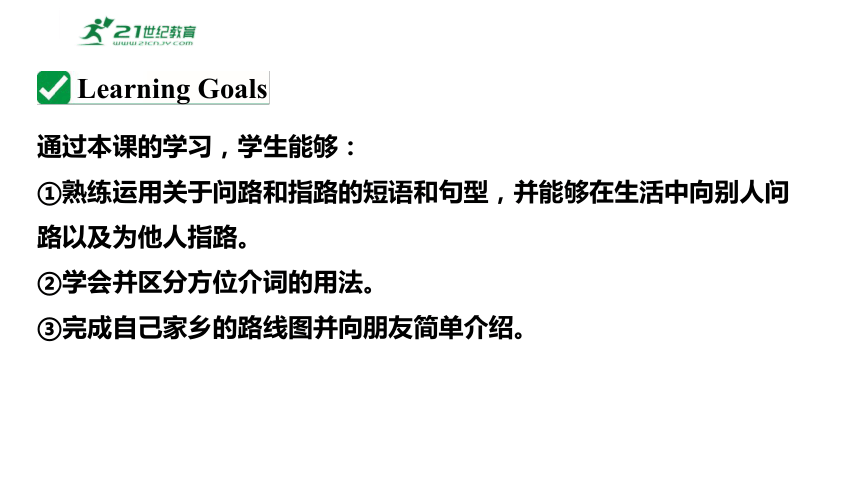
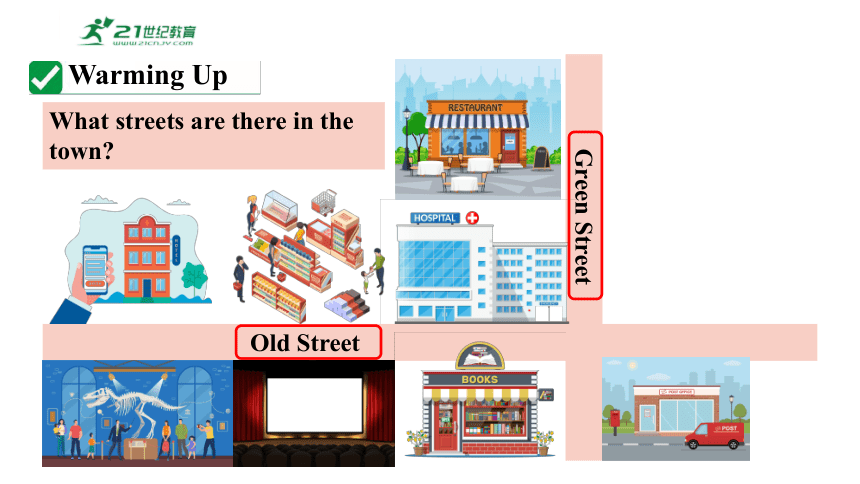
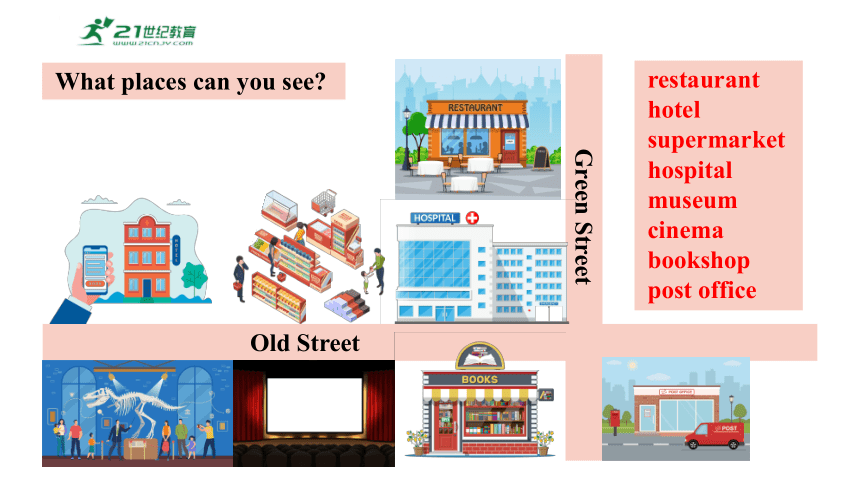
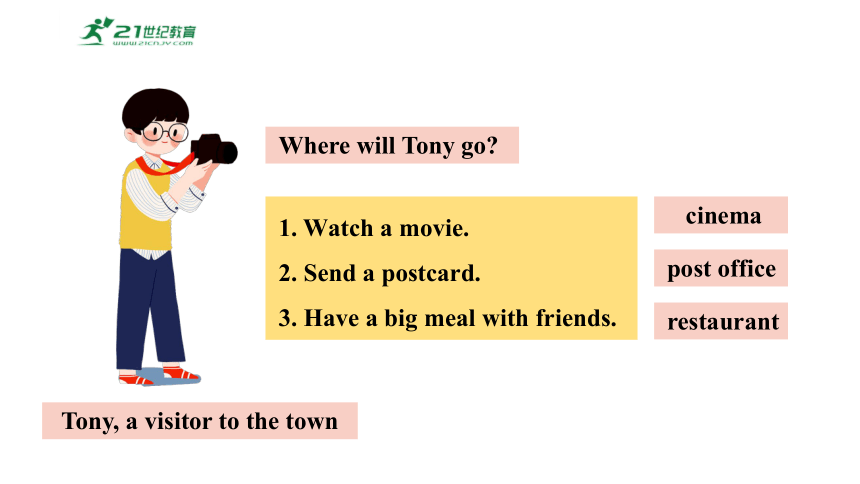
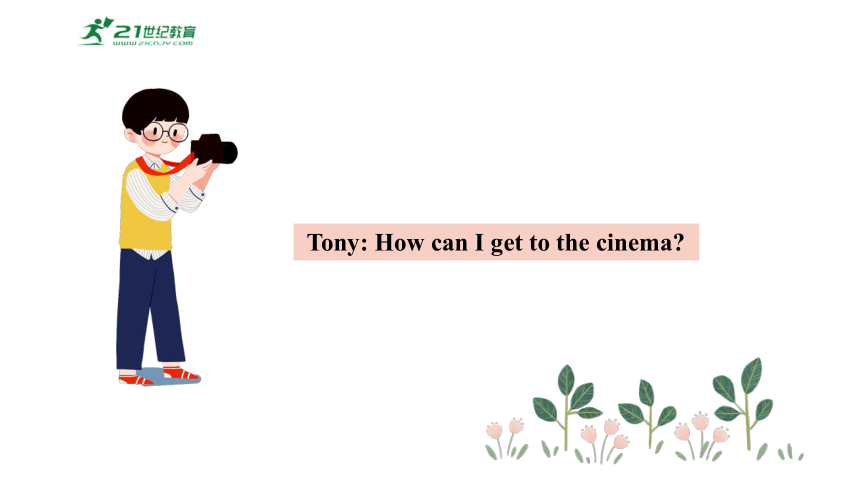

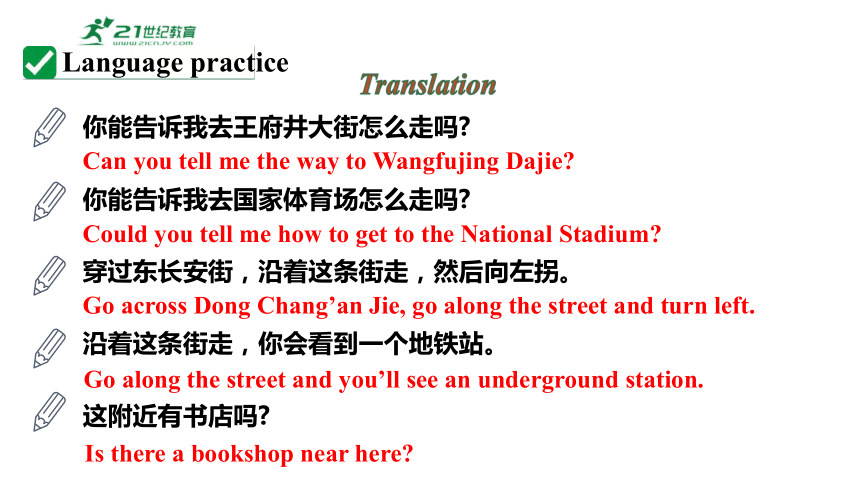

文档简介
(共27张PPT)
Module 6
Unit 3 Language in use
七年级下
外研版
Learning Goals
通过本课的学习,学生能够:
①熟练运用关于问路和指路的短语和句型,并能够在生活中向别人问路以及为他人指路。
②学会并区分方位介词的用法。
③完成自己家乡的路线图并向朋友简单介绍。
What streets are there in the town
Old Street
Green Street
Warming Up
What places can you see
restaurant
hotel
supermarket
hospital
museum
cinema
bookshop
post office
Old Street
Green Street
Where will Tony go
Tony, a visitor to the town
1. Watch a movie.
2. Send a postcard.
3. Have a big meal with friends.
cinema
post office
restaurant
Tony: How can I get to the cinema
Old Street
Green Street
Go across Old Street, and turn left.
The cinema is between the museum
and the bookshop.
Language practice
Translation
你能告诉我去王府井大街怎么走吗
你能告诉我去国家体育场怎么走吗
穿过东长安街,沿着这条街走,然后向左拐。
沿着这条街走,你会看到一个地铁站。
这附近有书店吗
Can you tell me the way to Wangfujing Dajie
Could you tell me how to get to the National Stadium
Go across Dong Chang’an Jie, go along the street and turn left.
Go along the street and you’ll see an underground station.
Is there a bookshop near here
Can you tell me the way to Wangfujing Dajie
Could you tell me how to get to the National Stadium
Go across Dong Chang’an Jie, go along the street and turn left.
Go along the street and you’ll see an underground station.
Is there a bookshop near here
Look at the sentences and tell me your finding.
the functional language of asking for, giving and following directions
1. 表示位置关系的介词叫方位介词
方位介词
in “在……里面”。表示在大地方的内部以及某个范围内。 e.g. There is a pencil in the box.
盒子里有一支铅笔。
at “在……”,一般用于较小的、比较具体的地点。 e.g. You can get off the bus at the next stop. 你可以在下一站下车。
on 表示“在……上面”,两者相互接触。 e.g. There is a book on the desk.
书桌上有一本书。
under 表示“在……的下面”,但两者不接触。 e.g. My shoes are under my bed.
我的鞋子在我的床底下。
behind 在……的后面 e.g. Lisa sits behind me.
丽莎坐在我的后面。
in front of 在……(外部)的前面 e.g. There is a car in front of the
house. 房子前面有一辆汽车。
next to 紧挨着;在……近旁 e.g. The bank is next to the library.
银行在图书馆近旁。
on the left/ right 在左/右边 e.g. The bookshop is on the
left/right. 书店在左/右边。
between 在……之间,指在两者之间 e.g. Our school is between the museum and
the bookshop.
我们学校在博物馆和书店之间。
above 在……上方 e.g. A bird is flying above us.
一只鸟正在我们上方飞。
opposite 在……的对面 e.g. The museum is opposite the
supermarket. 博物馆在超市的对面。
on the corner of 在……拐角处 e.g. The bookshop is on the corner of the
street. 书店在街道的拐角处。
2. 常见的问路与指路的表达方式:
(1) 问路
Where is… ……在哪里?
How can I go/get to… 我怎么能到达……?
Can you tell/show me the way to… 你能告诉我去……的路吗?
(2) 指路
Go along… 沿着……一直走。
Go across… 穿过……
Take the… / By… 搭乘……
Follow… 沿着……走。
Turn left/right. 向左/右拐。
1. Work in pairs and look at the map.
Student A: Choose a starting place on the map. Then give Student B
directions from there.
Student B: Listen to Student A and follow the directions: Where do
they finish
Now choose another starting place on the map.
Student B gives directions.
始发地
2. Read and label the places.
Man: I need to go to the post office. Can you tell me how to get there
Woman: Yes, of course. Turn left and walk up Green Street. Go past the bank. It’s the big building on the left. Turn right after the bank, at the cinema. The post office is opposite the cinema and the supermarket.
Man: Thanks. I also want to buy some books.
Woman: Well, there’s a good bookshop near the market. From here cross Green Street and turn right. Go past the market on your left. Then
turn left and go down the street to the bus stop. The bookshop is next to the bus stop.
Man: Thank you!
Bank
Post office
Supermarket
Market
Bookshop
3. Look at the map and complete the passage with the words and expressions from the box.
across between
next to on your right
opposite turn left
across between next to on your right opposite turn left
The museum is (1)________ the bank and the restaurant.
The park is along the street (2)________the bank. The shop is (3)________the restaurant. Cross the bridge and then go (4)________the street. (5)____________and the station is (6)_____________.
between
next to
opposite
across
Turn left
on your right
Around the world
Let’s watch a video about the Winter Palace.
A famous place
The Winter Palace in St Petersburg was a house for the Tsar of Russia. Now it’s part of the Hermitage Museum, and everyone can go and see the paintings and learn about Russian history. Opposite the museum, on the other side of the River Neva, is St Peter’s Church. You can walk across
the river over Trinity Bridge.
沙皇(大权独揽的人物)
在……的另一边
4. Write about your home town. Say:
Giving directions around your home town
· the most important places to see
· where they are
· how you get there
Module task
5. Write an email to a friend and say what to do on a one day tour of your home town. Use the information from Activity 4 to help you.
Dear Paul,
I’m really looking forward to your visit. There are three very interesting places to see in my hometown. They are the science museum, a beautiful park and a big market. The park is near my home. To get there, we can take a bus or we can walk. Then we can walk to the science museum.
It’s near the train station. Then we can buy some souvenirs at the market. To get to the market, we take a bus from opposite the science museum.
Hope to see you soon!
Yours,
Mark
6. Draw a map of your home town and mark out the important places.
1. Grammar:
To summarise and consolidate the functional language of asking for, giving and following directions.
2. Reading:
The Winter Palace in St Petersburg.
Summary
Module 6
Unit 3 Language in use
七年级下
外研版
Learning Goals
通过本课的学习,学生能够:
①熟练运用关于问路和指路的短语和句型,并能够在生活中向别人问路以及为他人指路。
②学会并区分方位介词的用法。
③完成自己家乡的路线图并向朋友简单介绍。
What streets are there in the town
Old Street
Green Street
Warming Up
What places can you see
restaurant
hotel
supermarket
hospital
museum
cinema
bookshop
post office
Old Street
Green Street
Where will Tony go
Tony, a visitor to the town
1. Watch a movie.
2. Send a postcard.
3. Have a big meal with friends.
cinema
post office
restaurant
Tony: How can I get to the cinema
Old Street
Green Street
Go across Old Street, and turn left.
The cinema is between the museum
and the bookshop.
Language practice
Translation
你能告诉我去王府井大街怎么走吗
你能告诉我去国家体育场怎么走吗
穿过东长安街,沿着这条街走,然后向左拐。
沿着这条街走,你会看到一个地铁站。
这附近有书店吗
Can you tell me the way to Wangfujing Dajie
Could you tell me how to get to the National Stadium
Go across Dong Chang’an Jie, go along the street and turn left.
Go along the street and you’ll see an underground station.
Is there a bookshop near here
Can you tell me the way to Wangfujing Dajie
Could you tell me how to get to the National Stadium
Go across Dong Chang’an Jie, go along the street and turn left.
Go along the street and you’ll see an underground station.
Is there a bookshop near here
Look at the sentences and tell me your finding.
the functional language of asking for, giving and following directions
1. 表示位置关系的介词叫方位介词
方位介词
in “在……里面”。表示在大地方的内部以及某个范围内。 e.g. There is a pencil in the box.
盒子里有一支铅笔。
at “在……”,一般用于较小的、比较具体的地点。 e.g. You can get off the bus at the next stop. 你可以在下一站下车。
on 表示“在……上面”,两者相互接触。 e.g. There is a book on the desk.
书桌上有一本书。
under 表示“在……的下面”,但两者不接触。 e.g. My shoes are under my bed.
我的鞋子在我的床底下。
behind 在……的后面 e.g. Lisa sits behind me.
丽莎坐在我的后面。
in front of 在……(外部)的前面 e.g. There is a car in front of the
house. 房子前面有一辆汽车。
next to 紧挨着;在……近旁 e.g. The bank is next to the library.
银行在图书馆近旁。
on the left/ right 在左/右边 e.g. The bookshop is on the
left/right. 书店在左/右边。
between 在……之间,指在两者之间 e.g. Our school is between the museum and
the bookshop.
我们学校在博物馆和书店之间。
above 在……上方 e.g. A bird is flying above us.
一只鸟正在我们上方飞。
opposite 在……的对面 e.g. The museum is opposite the
supermarket. 博物馆在超市的对面。
on the corner of 在……拐角处 e.g. The bookshop is on the corner of the
street. 书店在街道的拐角处。
2. 常见的问路与指路的表达方式:
(1) 问路
Where is… ……在哪里?
How can I go/get to… 我怎么能到达……?
Can you tell/show me the way to… 你能告诉我去……的路吗?
(2) 指路
Go along… 沿着……一直走。
Go across… 穿过……
Take the… / By… 搭乘……
Follow… 沿着……走。
Turn left/right. 向左/右拐。
1. Work in pairs and look at the map.
Student A: Choose a starting place on the map. Then give Student B
directions from there.
Student B: Listen to Student A and follow the directions: Where do
they finish
Now choose another starting place on the map.
Student B gives directions.
始发地
2. Read and label the places.
Man: I need to go to the post office. Can you tell me how to get there
Woman: Yes, of course. Turn left and walk up Green Street. Go past the bank. It’s the big building on the left. Turn right after the bank, at the cinema. The post office is opposite the cinema and the supermarket.
Man: Thanks. I also want to buy some books.
Woman: Well, there’s a good bookshop near the market. From here cross Green Street and turn right. Go past the market on your left. Then
turn left and go down the street to the bus stop. The bookshop is next to the bus stop.
Man: Thank you!
Bank
Post office
Supermarket
Market
Bookshop
3. Look at the map and complete the passage with the words and expressions from the box.
across between
next to on your right
opposite turn left
across between next to on your right opposite turn left
The museum is (1)________ the bank and the restaurant.
The park is along the street (2)________the bank. The shop is (3)________the restaurant. Cross the bridge and then go (4)________the street. (5)____________and the station is (6)_____________.
between
next to
opposite
across
Turn left
on your right
Around the world
Let’s watch a video about the Winter Palace.
A famous place
The Winter Palace in St Petersburg was a house for the Tsar of Russia. Now it’s part of the Hermitage Museum, and everyone can go and see the paintings and learn about Russian history. Opposite the museum, on the other side of the River Neva, is St Peter’s Church. You can walk across
the river over Trinity Bridge.
沙皇(大权独揽的人物)
在……的另一边
4. Write about your home town. Say:
Giving directions around your home town
· the most important places to see
· where they are
· how you get there
Module task
5. Write an email to a friend and say what to do on a one day tour of your home town. Use the information from Activity 4 to help you.
Dear Paul,
I’m really looking forward to your visit. There are three very interesting places to see in my hometown. They are the science museum, a beautiful park and a big market. The park is near my home. To get there, we can take a bus or we can walk. Then we can walk to the science museum.
It’s near the train station. Then we can buy some souvenirs at the market. To get to the market, we take a bus from opposite the science museum.
Hope to see you soon!
Yours,
Mark
6. Draw a map of your home town and mark out the important places.
1. Grammar:
To summarise and consolidate the functional language of asking for, giving and following directions.
2. Reading:
The Winter Palace in St Petersburg.
Summary
同课章节目录
- Module 1 Lost and found
- Unit 1 Whose bag is this?
- Unit 2 Are they yours?
- Unit 3 Language in use
- Module 2 What can you do ?
- Unit 1 I can play the piano
- Unit 2 I can run really fast
- Unit 3 Language in use
- Module 3 Making plans
- Unit 1 What are you going to do at the weekends?
- Unit 2 We're going to cheer the players.
- Unit 3 Language in use
- Module 4 Life in the future
- Unit 1 Everyone will study at home
- Unit 2 Every family will have a small plane.
- Unit 3 Language in use
- Module 5 Shopping
- Unit 1 What can I do for you?
- Unit 2 You can buy everything on the Internet
- Unit 3 Language in use
- Module 6 Around town
- Unit 1 Could you tell me how to get to the Nationa
- Unit 2 The London Eye is on your right.
- Unit 3 Language in use
- Revision module A
- Module 7 My past life
- Unit 1 I was born in a small village.
- Unit 2 I was born in Quincy.
- Unit 3 Language in use
- Module 8 Story time
- Unit 1 Once upon a time….
- Unit 2 Goldilocks hurried out of the house.
- Unit 3 Language in use
- Module 9 Life history
- Unit 1 He left school and began work at the age of
- Unit 2 He decided to be an actor.
- Unit 3 Language in use
- Module 10 A holiday journey
- Unit 1 What did you do?
- Unit 2 This morning we took a walk.
- Unit 3 Language in use
- Module 11 Body language
- Unit 1 They touch noses!
- Unit 2 Here are some ways to welcome them.
- Unit 3 Language in use
- Module 12 Western music
- Unit 1 It's so beautiful!
- Unit 2 Vienna is the centre of European classical
- Unit 3 Language in use
- Revision module B
